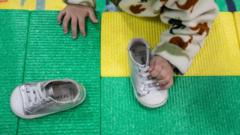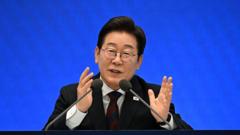Despite persistent societal challenges, a newfound determination among young couples reflects a desire to navigate parenthood with modern solutions.
**Fertility Clinics Thrive Amid South Korea's Low Birth Rate Crisis**

**Fertility Clinics Thrive Amid South Korea's Low Birth Rate Crisis**
As South Korea grapples with the lowest birth rate globally, the surge in fertility treatments is reshaping family planning.
In South Korea, where an alarming demographic crisis looms due to the world's lowest birth rates, the fertility industry is experiencing unprecedented growth. Kim Mi-ae, a 36-year-old Seoul resident, embarked on in vitro fertilisation (IVF) last November, anticipating a challenging journey. However, she was taken aback by the lengthy hospital waits, recalling, "It felt like everyone had made a New Year's resolution to have a baby!" As demand for fertility services rises, the number of treatments performed surged nearly 50% between 2018 and 2022, with one in six babies in Seoul conceived with assisted help last year.
This increase in fertility treatments signifies a cultural shift in attitudes towards family planning. Sarah Harper CBE, a professor at the University of Oxford, notes that the younger generation asserts control over their reproductive choices, opting for egg freezing and IVF when pregnancy doesn't happen naturally. The landscape of parenthood in South Korea is changing, as many women now prioritize planning and timing when starting families.
The South Korean government, facing a demographic disaster marked by a significant aging population, has welcomed this trend. With the country's record low birth rates—plummeting to 0.72 babies per woman in 2023—worry persists about the nation potentially halving its population in 60 years. However, there’s a glimmer of hope as birth rates slightly increased to 0.75 in 2024, prompting cautious optimism among experts regarding the long-term outlook for family growth.
For women like Park Soo-in, who delayed motherhood due to work commitments, marriage and the pursuit of a fulfilling job led to new perspectives on family. After facing challenges in conceiving, she and her husband turned to fertility treatments, mirroring a growing trend projected to escalate the industry’s valuation to over $2 billion by 2030. Jennifer Sciubba from the non-profit Population Reference Bureau asserts that these trends highlight unmet desires for parenthood among many women.
Obstacles such as financial strain and societal expectations contribute significantly to the age at which women in South Korea have their first child, now averaging 33.6 years—one of the highest globally. Kim Mi-ae recalls her lengthy journey of saving for marriage and childbearing, noting that educational and economic pressures too often delay family planning until it's more complex.
Those opting for IVF encounter substantial financial burdens, with costs varying widely and many expenses falling outside governmental subsidies. While the South Korean government has stepped in to support families financially—covering some IVF treatment costs—experiences like that of Jang Sae-ryeon, who faced multiple unsuccessful cycles, reveal the harsh realities of fertility struggles. “Without money, you simply can’t move forward,” she lamented.
An affecting aspect of fertility treatment is workplace culture, with many women finding it difficult to balance demanding jobs with the rigorous scheduling that IVF demands. Neither Kim nor Jang could fully utilize the leave purportedly available for fertility treatments, leading to difficult work-life conflicts.
Despite these challenges, women like Jang Sae-ryeon remain hopeful, reflecting on their dreams of thriving families. She reminisces about her aspirations of creating a life with a child resembling both her and her husband, reinforcing that the desire for motherhood persists amidst societal obstacles. In a nation grappling with dwindling birth rates, the evolution of fertility practices may lay the groundwork for renewed familial prospects in the future.
This increase in fertility treatments signifies a cultural shift in attitudes towards family planning. Sarah Harper CBE, a professor at the University of Oxford, notes that the younger generation asserts control over their reproductive choices, opting for egg freezing and IVF when pregnancy doesn't happen naturally. The landscape of parenthood in South Korea is changing, as many women now prioritize planning and timing when starting families.
The South Korean government, facing a demographic disaster marked by a significant aging population, has welcomed this trend. With the country's record low birth rates—plummeting to 0.72 babies per woman in 2023—worry persists about the nation potentially halving its population in 60 years. However, there’s a glimmer of hope as birth rates slightly increased to 0.75 in 2024, prompting cautious optimism among experts regarding the long-term outlook for family growth.
For women like Park Soo-in, who delayed motherhood due to work commitments, marriage and the pursuit of a fulfilling job led to new perspectives on family. After facing challenges in conceiving, she and her husband turned to fertility treatments, mirroring a growing trend projected to escalate the industry’s valuation to over $2 billion by 2030. Jennifer Sciubba from the non-profit Population Reference Bureau asserts that these trends highlight unmet desires for parenthood among many women.
Obstacles such as financial strain and societal expectations contribute significantly to the age at which women in South Korea have their first child, now averaging 33.6 years—one of the highest globally. Kim Mi-ae recalls her lengthy journey of saving for marriage and childbearing, noting that educational and economic pressures too often delay family planning until it's more complex.
Those opting for IVF encounter substantial financial burdens, with costs varying widely and many expenses falling outside governmental subsidies. While the South Korean government has stepped in to support families financially—covering some IVF treatment costs—experiences like that of Jang Sae-ryeon, who faced multiple unsuccessful cycles, reveal the harsh realities of fertility struggles. “Without money, you simply can’t move forward,” she lamented.
An affecting aspect of fertility treatment is workplace culture, with many women finding it difficult to balance demanding jobs with the rigorous scheduling that IVF demands. Neither Kim nor Jang could fully utilize the leave purportedly available for fertility treatments, leading to difficult work-life conflicts.
Despite these challenges, women like Jang Sae-ryeon remain hopeful, reflecting on their dreams of thriving families. She reminisces about her aspirations of creating a life with a child resembling both her and her husband, reinforcing that the desire for motherhood persists amidst societal obstacles. In a nation grappling with dwindling birth rates, the evolution of fertility practices may lay the groundwork for renewed familial prospects in the future.




















